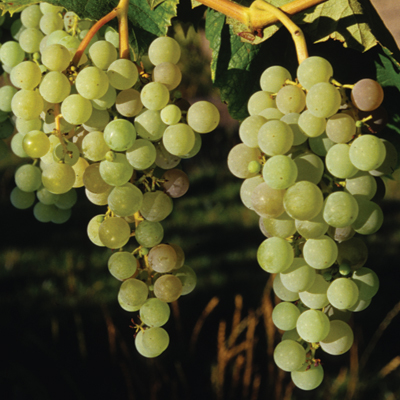
Seattle's coolest little Garden Center with perennials, shrubs, trees, containers or pottery for creating great gardens or planted containers
Citrus-Lemons, Oranges & Limes
About Garden Center and Gift Shop
3213 West Smith
and around the corner
our new Gift Shop at
2455 32nd Ave West
Seattle, WA 98199
Mon-Fri 9:30am- 6:00pm
Sat 9:00am- 6:00pm
Sun 10:00am- 5:00pm
Tel: (206) 284-1161
Fax: (206) 284-0081
Email
MasterCard, Visa
FRUITS & BERRIES
*Pictures courtesy of Northwoods Nursery*
There is nothing better than going out to your garden in the summer and harvesting your very own crop of fresh, delectable berries. Here in the pacific Northwest, we have the luxury of growing many different types of edible berries including familiars types like raspberries, to more unusual varieties such as Goji berry.
Here at Magnolia Garden Center, we have a great selection of berry plants and vines, for your spring planting season. Varieties change frequently, so call for the latest varieties in stock.
(Call for current availability)
 Black
Currant
Black
Currant
Consort - Clusters of medium-sized, black, sweet-tart musky fruits ripen in late summer. Developed by Agriculture Canada, an old variety immune to White Pine Blister Rust. Upright, multi-stemmed shrubs bear fragrant flowers in spring and brilliant orange red foliage in fall. Great for jams and preserves. Very high in vitamin C. 4-5 feet tall and wide.
Blueberries - See Link
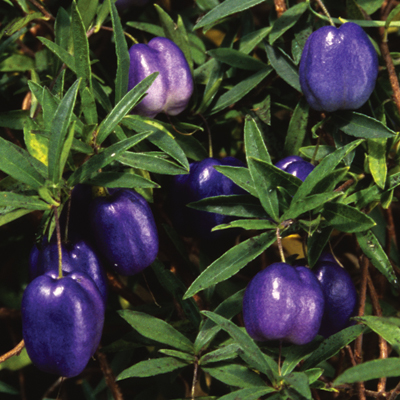 Blue
Tasmania Vine - A choice Tasmanian climber that sports thin
twining stems that produce creamy-yellow purple-tipped waxy flowers in
spring. In autumn, outstandingly lovely clusters of deepest violet
grape-sized berries appear when this unusual color for autumn is
appreciated. Hardy in zones 7-9, this variety grows 6-10 feet in full to
part sun.
Blue
Tasmania Vine - A choice Tasmanian climber that sports thin
twining stems that produce creamy-yellow purple-tipped waxy flowers in
spring. In autumn, outstandingly lovely clusters of deepest violet
grape-sized berries appear when this unusual color for autumn is
appreciated. Hardy in zones 7-9, this variety grows 6-10 feet in full to
part sun.
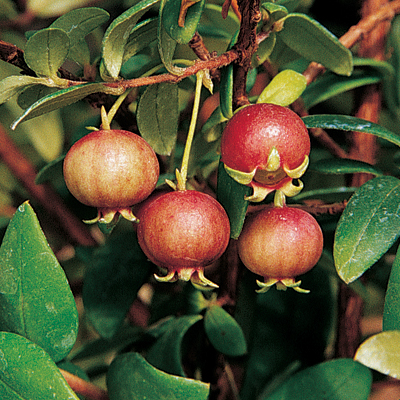 Chilean
Guava - The Chilean Guava is a perennial bush that grows
about 5 or 6 feet tall and wide. It's an attractive plant with deep-green
foliage and pink, bell-shaped flowers in the spring. The plant is
self-pollinating, so only one plant is needed to make fruit. Around
September, the ½" berries begin to ripen, filling the garden with their
sweet, cotton-candy aroma. The entire fruit is edible, including the tiny
seeds. They have a nice balance of tangy and sweet, and are not too tart
like some berries. A mature plant can yield a few pounds of fruit. The
fruit can be used to make muffins, ice cream, and jams.
Chilean
Guava - The Chilean Guava is a perennial bush that grows
about 5 or 6 feet tall and wide. It's an attractive plant with deep-green
foliage and pink, bell-shaped flowers in the spring. The plant is
self-pollinating, so only one plant is needed to make fruit. Around
September, the ½" berries begin to ripen, filling the garden with their
sweet, cotton-candy aroma. The entire fruit is edible, including the tiny
seeds. They have a nice balance of tangy and sweet, and are not too tart
like some berries. A mature plant can yield a few pounds of fruit. The
fruit can be used to make muffins, ice cream, and jams.
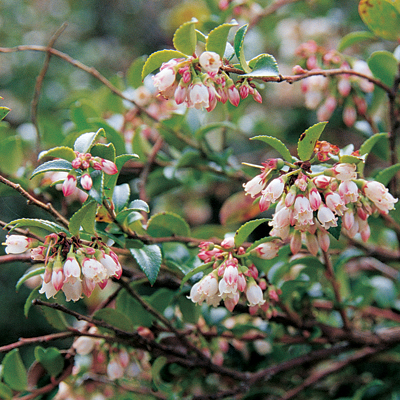 Evergreen
Huckleberry - This remarkable evergreen native shrub can grow
in either sun or shade and is tolerant of salt spray. As a natural or
trimmed hedge, hedgerow, or in a thicket as wildlife habitat, it makes a
choice plant for the garden. It even grows well in a container. The small,
ovate, evergreen foliage looks good year round, has little urn-shaped
flowers, followed by glossy, blackish-purple berries. In a partial shade
garden, the shrubs are a beautiful backdrop for mixed borders. In a full
shade garden, grow it as a tall evergreen hedge. In a full sun garden, it
will produce more berries but it will not grow as tall as it will in the
shade garden. Indigenous Northwest tribes relished the berries of this shrub
and would travel long distances to harvest them.
Evergreen
Huckleberry - This remarkable evergreen native shrub can grow
in either sun or shade and is tolerant of salt spray. As a natural or
trimmed hedge, hedgerow, or in a thicket as wildlife habitat, it makes a
choice plant for the garden. It even grows well in a container. The small,
ovate, evergreen foliage looks good year round, has little urn-shaped
flowers, followed by glossy, blackish-purple berries. In a partial shade
garden, the shrubs are a beautiful backdrop for mixed borders. In a full
shade garden, grow it as a tall evergreen hedge. In a full sun garden, it
will produce more berries but it will not grow as tall as it will in the
shade garden. Indigenous Northwest tribes relished the berries of this shrub
and would travel long distances to harvest them.
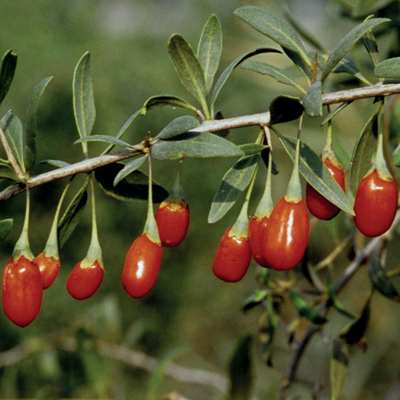 Goji
Berry
Goji
Berry
Crimson Star - Goji berry is one of nature’s most nutrient-rich foods. This superfruit is packed with vitamins, minerals and antioxidants. A deciduous perennial plant, it grows from 3-9’ in height. Purple flowers appear in late spring to early summer and the bright orange-red Goji berries ripen from August to October. The sweet tasty fruit is harvested by shaking the vine. Once the berries, about the size of a raisin, are fully ripe, they fall off the vine easily. The berries may be eaten fresh or sun-dried to be enjoyed later. Plant in full sun and well-drained soil. Hardy to zone 5.
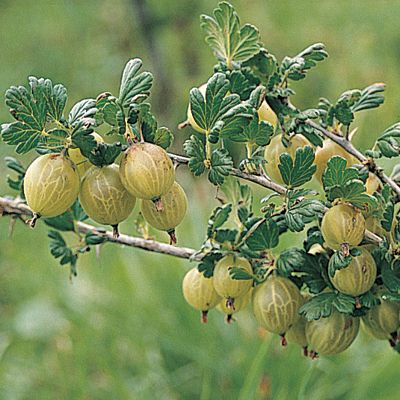 Gooseberry
Gooseberry
Pixwell - Medium-sized pinkish berries have superb flavor. Delicious for fresh eating or for pies and jellies. Vigorous, bushy, almost thornless plants are very hardy and bear abundant fruit that ripen in July. Self-pollinating. Deciduous. Fast grower to 5 ft. tall, 3 ft. wide. Zone 3-8.
Himrod - Vigorous deciduous vine with bold-textured, deep green foliage. Grown for its clusters of small, firm, crisp, greenish-white seedless berries. Excellent flavor. Ripens very early. Fast-growing vine to 20 to 25 ft. each year. Zone 5-8.
Lakemont - A great addition to the White Seedless family, easy to grow and disease resistant. Lakemont is a sister seedling to both Himrod and Interlaken. Its vigorous, and a good producer. Lakemont has the largest and tightest cluster of all the seedless. Berries are golden in color, crisp, juicy, and sweet as honey. A great grape for eating and roadside stands. Zones 5-8
Vanessa - Vanessa yields bumper crops of some of the most delicious, seedless grapes you’ll ever eat. Vanessa looks as good as it tastes, with a blushing-red, almost translucent skin that adds zest to its flavor. Firm yet tender flesh melts smoothly on the tongue to release a sweet, tangy flavor. Because it is very firm, it keeps extremely well under ordinary refrigeration. Squeeze it for juice, make grape pies, or jam and jelly that wake up your taste buds. Vine-ripened and chilled, Vanessa’s flavor beats any grapes sold in stores. Resists grape pests with little or no spraying. Zones 5-8.
Kiwi
Hardy Kiwi - Kiwis require a male and female plant for pollination. Hardy kiwi has emerald-green flesh and a sweet taste similar to fuzzy kiwi, but they’re smaller and you eat them like a grape, tender skin and all.
Rosy Crabapple Kiwi - Wow! What a great and uncommon vine! Even when young, this Kiwi shows wonderful white tipped foliage and clusters of beautiful pink blossoms in spring. The texture effect in your garden will be magnificent! Zones 6 to 9, grows 15 to 25 feet
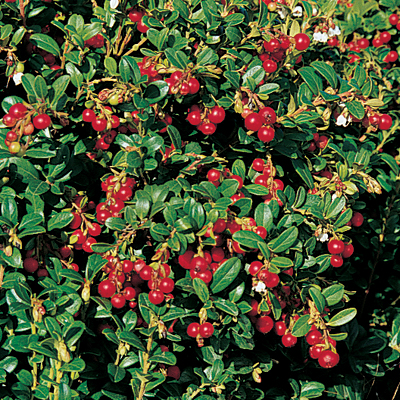 Ligonberry
Ligonberry
Koralle - A low, dense shrub that creeps to form a thicket. Small white to pale pink flowers appear mid- spring and 1-2 crops of large, bright red berries ripen in summer. Mahogany winter foliage. A beautiful ornamental as well as a nutritious fruit crop. Prefers afternoon shade in our climate. Semi-evergreen. Hardy to -50°F.
Loganberry (Thorn less) - The thorn less Logan is thought to be a wild cross between a blackberry and a red raspberry. Plants are only about half as productive as either Marionberry or Tayberry, but large, flavorful fruit has a unique quality that is highly prized. Many people prefer the flavor to all others. USDA Zones 6-10.
Raspberries
More Coming on 5/14/15 Raspberry Shortcake™ Dwarf Thornless Raspberry The perfect raspberry for decks, patios and back yards. These plants grow to only 3 feet and need no staking. Delicious fruit on a compact plant growing on your deck! What more could you hope for?
Anne - Known for the size, color and super-sweet flavor of its berries!
We think it’s the best-flavored yellow variety available. Ripens late Aug.
through Oct. Self-pollinating. 4-6 feet tall. Zone 4-9.
Autumn Britten - The Autumn Britten Raspberry has excellent fruit firmness and is also a better producer than other raspberries. The berries are long, conical shaped, with bright red color and good flavor. Autumn Britten has a good upright growth habit. Plants are moderately vigorous, and we recommend planting at 22"-24" in-row spacing. The berries are versatile and can be used as fresh fruit, in preserves, or in pies and pastries.
Indian Summer - This ever-bearing variety produces a small crop in late Spring and a larger crop in Fall. Canes grow to about five feet and are vigorous, erect and sturdy. The fruit is red, medium-large sized with great raspberry flavor, excellent for fresh eating or cooking. Use as an edible security barrier along fence lines and in strips too narrow for fruit trees.
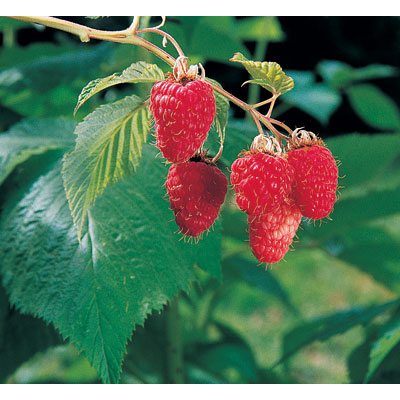 Meeker
- 'Meeker' bears large, firm, brilliant red fruits on spreading
laterals. They are generally thorny. A slow warming spring, such as in the
Pacific Northwest, is required for optimal flower and fruit production.
Staking is also usually necessary. White flowers are followed by the much
anticipated red or sometimes yellow fruit in late summer. Fruit is produced
on one year old wood. For best results, cut down all fruited canes to ground
level at the end of the season.
Meeker
- 'Meeker' bears large, firm, brilliant red fruits on spreading
laterals. They are generally thorny. A slow warming spring, such as in the
Pacific Northwest, is required for optimal flower and fruit production.
Staking is also usually necessary. White flowers are followed by the much
anticipated red or sometimes yellow fruit in late summer. Fruit is produced
on one year old wood. For best results, cut down all fruited canes to ground
level at the end of the season.
Willamette - Make room for this prolific producer of juicy raspberries - the canes can grow up to 10 feet long. Tasty dark red fruit appears in midsummer to fall of second year. A large crop ripens in summer and a smaller one later in the year. Small white flowers precede fruit on erect canes. Deciduous.
Rhubarb
Crimson Cherry - This maintains its bright red color even after cooking)- A bright red stalked variety of rhubarb which is less showy in flowers than most but it has attractive and prolific leaf development; only the crimson stems are edible, other plant parts are poisonous. 4' tall and wide. Zone 3.
Chipman's Canada Red - Large stalks, yields 4-12 lbs. per crown. Color won't fade during cooking. Sweetest of all, needs less sugar when baking than others. Harvest well into fall, seldom goes to seed. Rhubarb is a long lived perennial. Dependable producers red stalks. Simmer, boil or bake. Perfect for preserves. Takes 2 years before ready to harvest. 2-3 feet tall and wide. Zone 3.
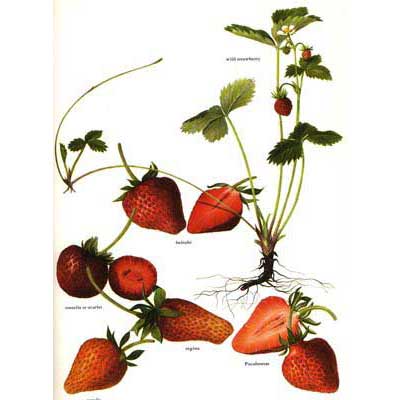 Strawberries
Strawberries
Eversweet - Very large, deep red fruit. Everbearing. Thrives in the heat and humidity and still produces exceptional fruit. Bred for Southern growers. Tolerates temperatures over 100 degrees without loss of fruit.
Sequoia - This excellent home garden variety yields exceptionally large, dark red fruit from late spring through autumn. Although it is June bearing, Sequoia strawberry plants produce like an everbearing strawberry in mild climates, putting on berries through the warm season. The berries are firm at first and soften as they enlarge. Resistant to powdery mildew.
Puget Crimson - Large, sweet, very flavorful berries ripen late season past the traditional mid June time frame. A great berry to mix with your earlier ripening plants to extend your harvest.
Questions about our Berries? Email Chuck! Looking for something in particular? We take special orders. Just call us! Don't know what you want? Just stop by and we can help!
